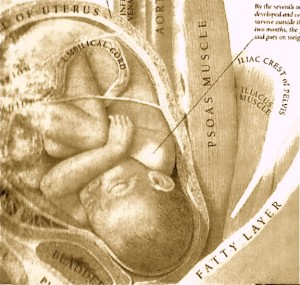On the Facebook forum of TRE I was intrigued by a post of Terry Wood linking to the big amount of hits using a search machine on internet. Indeed, if you google this question, you will find lot’s of mothers asking if what they are feeling is a tremoring baby inside the womb. I can confirm having the same feeling, and I tried to make a video, showing the movements of my baby inside my belly!
When I then watched this beautiful video „The miracle of life”, I felt reassured, that baby’s indeed tremble, shake and have unconscious movement patterns that are similar to those you can experience while tremoring with TRE.
There is a lot of information about the impact of stress on the foetus. A nice TED talk of Anna Verwaal (member of the association of Pre- and Perinatal Psychology and Health).
And the following podcast of Liz Koch and Verwaal explains how important it is for the fetus to already feel welcome, calm and relaxed from the onset of the pregnancy. Furthermore, as my third article explained, we know giving birth is more easy when calm and relaxed. It seems that our personal and cultural story is embodied within our iliopsoas.
 „Early childhood conditioning, combined with life experiences, form profound somatic impressions upon the iliopsoas. Whether from overt or subtle abuse or impoverishment, developmental disruptions play themselves out during the birthing process. For example premature walking, encouraged by holding a baby’s hands above their head, can disrupt a developing awareness of support found within the bones. By shifting the center of gravity, premature walking encourages the child to rely upon muscular support. Rather than swinging freely, the iliopsoas muscle may be engaged as a structural anchor. Such early childhood experiences influence how the pregnant woman copes with the additional weight of childbearing. If her sense of support is dependent upon muscles rather than bones, any additional weight will automatically be experienced as increased stress. Similarly, years of competitive athletics which focuses on highly conditioned muscular control can interfere with the spontaneous, involuntary processes that involves a supple iliopsoas, so essential for vaginal birth.”
„Early childhood conditioning, combined with life experiences, form profound somatic impressions upon the iliopsoas. Whether from overt or subtle abuse or impoverishment, developmental disruptions play themselves out during the birthing process. For example premature walking, encouraged by holding a baby’s hands above their head, can disrupt a developing awareness of support found within the bones. By shifting the center of gravity, premature walking encourages the child to rely upon muscular support. Rather than swinging freely, the iliopsoas muscle may be engaged as a structural anchor. Such early childhood experiences influence how the pregnant woman copes with the additional weight of childbearing. If her sense of support is dependent upon muscles rather than bones, any additional weight will automatically be experienced as increased stress. Similarly, years of competitive athletics which focuses on highly conditioned muscular control can interfere with the spontaneous, involuntary processes that involves a supple iliopsoas, so essential for vaginal birth.”From BIRTHING FEAR: The Iliopsoas Muscle printed in Midwiferey Today 2009. The complete article available at www.coreawareness.com under Books & CDs
When you realize the Illiopsoas muscle tension holds most of our tension/trauma patterns, and when you realize this muscle is important in core stability and relaxation during pregnancy and birth. I find it even more important to get pregnant women, midwives, doctors and partners involved in how TRE can help release tension. I hope that sharing my experiences will give insights to you as a reader/practitioner/teacher to explore the benefits of TRE while pregnant as well.
As an extra….I love to also tell you about the beautiful research of Melanie Salamon in South-Africa in an SOS children’s village. During this project, the quality of life of the ‚mothers’ improved greatly using TRE to release stress. Moreover, their calm states had a profound impact on the children. They tended to be less aggressive, listen better and fight less. Then when the children also learned to use TRE to release tension themselves, the bedwedding decreased enormously.
Thus also if your children are already long born, imagine the profound impact you can still have on your children, releasing your tension using TRE.
